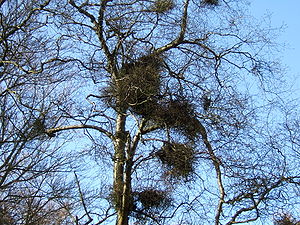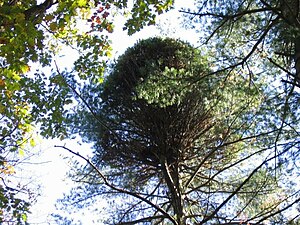Witch's broom


A Witch's broom is a disease or deformity in a woody plant, typically a tree, where the natural structure of the plant is changed. A dense mass of shoots grows from a single point, with the resulting structure resembling a broom or a bird's nest.
One example of this would be cytokinin, a phytohormone, interfering with an auxin-regulated bud. Usually auxin would keep the secondary, tertiary, and so on apexes from growing too much, but cytokinin releases them from this control, causing these apexes to grow into witch's brooms.
Witch's broom growths last for many years and can be caused by many different types of organisms, such as fungi, insects, mistletoe, dwarf mistletoes, mites, nematodes, phytoplasmas and viruses.[1] Human activity is sometimes behind the introduction of these organisms; for example when a person prunes a tree improperly, leaving the tree susceptible to disease.
Witch's brooms occasionally result in desirable changes. Some cultivars of trees, such as Picea orientalis 'Tom Thumb Gold', were discovered as witch's brooms. If twigs of witches' brooms are grafted onto normal rootstocks, freak trees result, showing that the attacking organism has changed the inherited growth pattern of the twigs.[1]
Witch's brooms are used by various animals for nests including the northern flying squirrel[1]
